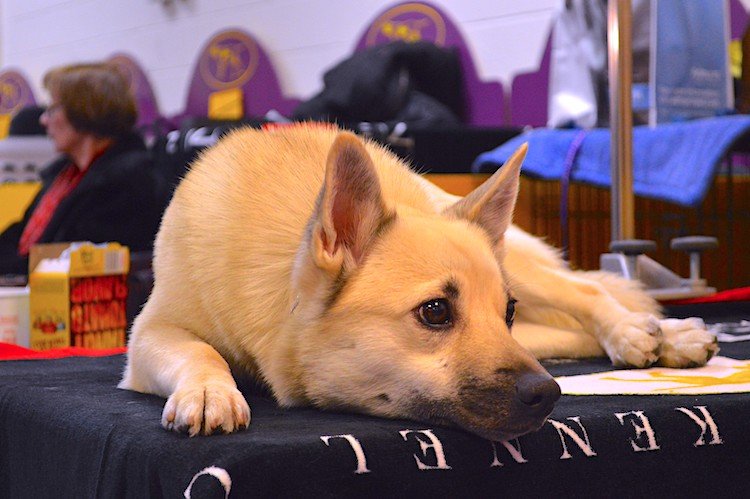
Herding
26-40 lbs.
16-18.5 in.
13-15 years
1. Key Characteristics of Norwegian Buhunds
The Norwegian Buhund (boo-hund) is a medium-sized, Spitz-type herding dog who might also be called the Norsk Buhund or the Norwegian Sheepdog.
The dogs have medium-sized ears that stand erect and have pointed tips. The oval-shaped eyes are dark, and the eye rims are black. The nose and lips are also black.
The high-set tail is tightly curled and carried over the back. Featuring a thick topcoat and a soft, dense undercoat, coat colors can be black and wheaten. A black mask may be present, as well as white markings.
2. Where Norwegian Buhunds Come From
Originally herders, Norwegian Buhunds come from Norway. Evidence of the breed dates to 900 A.D. — in fact, canine skeletons of the breed were found in a Viking grave in the Gokstad excavation.
The first Norwegian Buhund show in Norway was held in 1920. The Norsk Buhund Club formed in 1939, and the Norwegian Buhund Club of America was formed in 1983.
The Norwegian Buhund was entered in the American Kennel Club (AKC)’s Foundation Stock Service in 1996. The breed was moved to the Miscellaneous Class in 2006 and officially recognized in the Herding Group in 2009.

3. How Friendly Are Norwegian Buhunds?
Happy, playful dogs, Norwegian Buhunds love being with family members and children. Though generally good around other pets, these dogs need to be socialized.
These intelligent dogs are easy to train and can be taught tricks. They are sensitive to harsh discipline, so use only positive reinforcement.
Exercise your Norwegian Buhund regularly to avoid boredom or destructive behavior.
The breed has a strong, high-pitched bark and may try to herd people, so make sure to correct this behavior.
4. Is This the Right Dog for You?
Exercise Needs
HIGH: These dogs need daily exercise and consistent training. They tend to settle down in the evenings and snuggle with their humans.
Norwegian Buhunds do well in large apartments if they can exercise outside each day.
Grooming Needs
LOW: Minimal shedding for most of the year means the Norwegian Buhund’s coat is easy to maintain with regular brushing. Be warned, though: Heavy shedding occurs seasonally, usually twice a year, when you’ll need to brush your dog daily.
Aside from that, bathe your dog, brush the teeth, clean the ears and trim the nails as needed.
Health Problems
LOW: This breed is considered extremely healthy. Only hip dysplasia and eye problems (cataracts) seem to commonly affect Norwegian Buhunds.
More Stats About Norwegian Buhunds
| Friendliness | ★★★★☆ |
| Ease of Training | ★★★★☆ |
| Barking/Howling | ★★★★☆ |
| Shedding | ★★★☆☆ |
| Tolerate Being Alone | ★★★★☆ |
| Very Good With Kids | ★★★★★ |
In this video, Norwegian Buhund “Binna” demonstrates her high-five trick at the Westminster Kennel Club Dog Show:

5. How to Adopt a Norwegian Buhund
Norwegian Buhunds can be difficult to find, but it’s worth checking shelters and rescues first. Use our online dog search to find one near you.
Contacting a breeder? Make sure they’re members of the Norwegian Buhund Club of America or have solid references you can check. Also, be aware of warning signs that the breeder is operating a puppy mill.
References
- “Norwegian Buhund.” American Kennel Club. https://www.akc.org/dog-breeds/norwegian-buhund/.
- Norwegian Buhund Club of America. https://www.facebook.com/buhund.org/.
- “Breed Information.” Norwegian Buhund Club of the UK. https://norwegianbuhund.org.uk/breed-info/.








